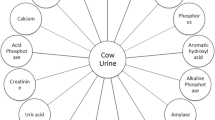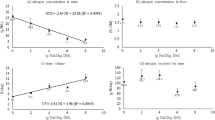Abstract
The ancient scientific Sanskrit texts of Ayurveda (science of longevity) deal with waters, plants, and animals in relation to human health. Based on the studies mentioned in Ayurveda and modern literature, biological responses of grazing animals in Mangampeta barite mining area in Kadapa District, Andhra Pradesh, were studied. A non-mineralized Tirupati area in Chittoor District, Andhra Pradesh, was selected for the purpose of comparison. In these areas, certain animal products of selected grazing animals were studied if they could be used as tools in mineral exploration. Samples of dung, urine, and milk from cow, bullock, she-buffalo, he-buffalo, sheep, and goat were collected from these two areas during winter and summer seasons. Goat dung was found to have lowest moisture content and highest organic matter while goat urine contained highest amounts of organic matter and ash content. All these animal products were analyzed for 11 trace elements. The concentration of trace elements released through dung, urine, and milk widely varied in different animal species with seasonal variations. The elemental concentration was higher in dung and lower in urine, when compared to that of milk. The concentration of all elements in dung, urine, and milk of all animals, in both the areas, was higher in winter than that in summer. Dung represents the metabolic process of the whole animal and reflects the dietary conditions whether fed on natural or inorganic supplement. It can be inferred that dung, urine, and milk of any animal can be used as tools in mineral exploration during winter, while during summer, only dung can be useful. The dung of goat when compared to that of the other cattle serves as a better tool in environmental studies as goat depends almost entirely on natural vegetation without human interference.


Similar content being viewed by others
References
Arbuckle, W. S. (1977). Ice Cream (3rd edn.). Connecticut: AVI Publishing Company Inc.
Balfour, E. (1884). Encyclopedia Asiatica (pp. 855–1280). New Delhi: V.3 Cosmo Publications.
Barshad, I. (1948). Molybdenum content of pasture plants in relation to toxicity to cattle. Soil Science, 66, 187–195.
Bose, R. N., & Vaidyanathan, N. C. (1979). Gravity surveys for barites around Mangampeta, Cuddapah District, Andhra Pradesh. The Journal of Geological Society of India, 11, 540–547.
Brooks, R. R. (1972). Geobotany and biogeochemistry in mineral exploration (p. 290p). New York: Harper and Row.
Brooks, R. R. (1983a). Biological methods of prospecting for minerals (p. 322). New York: Wiley.
Brooks, R.R. (1983b). Geozoology in mineral exploration, Episodes, (3), 27–32.
Chandrasekhar Reddy, L. (1995). Some biogeochemical aspects of barite and asbestos mining areas of Pulivendula Taluk, Cuddapah District, Andhra Pradesh, India (p. 224). Unpublished Ph.D. thesis. Tirupati: Sri Venkateswara University
Chebaevskaya, V.S. (1960). Dynamics of the content and distribution of micro elements in plants (in Russian), Izv.sell-khoz. Akad. K.A. Timiryazeva, (5), 123–134.
Conrad, J. H., Mc Dowell, L. R., & Loosli, J. K. (1982). Mineral deficiencies and toxicities for grazing ruminants in the tropics. In M. K. Yousef (Ed.), Animal production in the tropics (pp. 73–106). New York: Praeger Publishers.
Davies, B. E. (1983). Heavy metal contamination from base metal mining and smelting: implications for man and his environment. In I. Thornton (Ed.), Applied environmental geochemistry (pp. 425–462). London: Academic.
Debski, B., Krynski, A., & Skrzymowska, K. (2005). Selenium concentration in musk rat, hare, cow tissues and in cow’s milk, as an indicator of its status in local ecosystem: ISAH, 2, Warsaw, Poland, 442–445.
Dey, S., Stafford, R., Deb Roy, M. K., Bhattacharjee, C. R., Khathing, D. T., & Bhattacharjee, P. C. (1999). Metal toxicity and trace element deficiency in some wild animal species from North-east India, as revealed by cellular, bio-inorganic and behavioural studies. Current Science, 77(2), 276–280.
Dobrzanski, Z., Kolacz, R., Gorecka, H., Chojnacka, K., & Bartkowiak, A. (2005). The content of microelements and trace elements in raw milk from cows in the Silesian region. Polish Journal of Environmental Studies, 14(5), 685–689.
Filistowicz, A., Dobrzanski, Z., Przysiecki, P., Nowicki, S., & Filistowicz, A. (2011). Concentration of heavy metals in hair and skin of silver and red foxes (Vulpes vulpes). Environmental Monitoring and Assessment, 182(1–4), 477–484.
Guru Rao, P. (Ed.) (1935). Punyahavachana Vidhihi: Panchagavya Vidhaha, (in Sanskrit and Kannada), Sriman Madhva Siddhanta Granthalaya, Udipi, 64 p.
ICAR. (Indian Council of Agriculture Research), (1961). Proceedings of the symposium: Radio- isotopes Fertilizers and cow dung Gas-plant, New Delhi, 438 p.
Karunakaran, C. (1976). Sulphur isotopic composition of barite and pyrites from Mangampeta, Cuddapah District, Andhra Pradesh. The Journal of Geological Society of India, 17(2), 181–185.
Kon, S.K. (1972). Milk and Milk Products in Human Nutrition: Food and Agriculture Organization of the United Nations, Rome, 80 p.
Kurien, T. K., Setty, D. N., Neelakantam, S., Suthanandam, P., & Roy, S. (1977). Baryte mineralization and its origin, Mangampeta, Cuddapah District, Andhra Pradesh. The Indian Mineralogist, 18, 1–6.
Lee, H. J. (1975). Trace elements in animal production. In D. J. D. Nicholas & A. R. Egan (Eds.), Trace elements in soil-plant-animal systems (pp. 39–54). New York: Academic.
Lorinţ, C., Rădulescu, M., & Buia, G. (2012). Influence of grazing practices on cow milk quality: a case study on the Comarnic–Poieni bauxite quarry, Romania. Journal of Environmental Geochemistry and Health, 34(2), 289–295.
Maymand, O.E., & Samimi, A. (2009). Mail utility of goat dung (feces) as a bio- monitor for geochemical exploration and prospecting copper deposits based on a study on Maymand area from Kerman province, Iran. Water and Geoscience, 196–198.
Nakayama, S. M. M., Ikenaka, Y., Hamada, K., Muzandu, K., Choongo, K., Yabe, J., Umemura, T., & Ishizuka, M. (2013). Accumulation and biological effects of metals in wild rats in mining areas of Zambia. Environmental Monitoring and Assessment, 185(6), 4907–4918.
Neelakantam, S., & Sabyasachi, R. (1979). Barytes deposits of Cuddapah basin. Records Geological Survey of India, 112(part-5), 51–64.
Nicholas, D. J. D., & Egan, A. R. (Eds.). (1975). Trace elements in soil-plant–animal systems. New York: Academic.
Prasad, E. A. V., Raghu, V., & Sankaranna, G. (1993). The significance of cattle dung in biogeochemical exploration. In K. L. Rai (Ed.), Development of India’s mineral resources: geological and mineral economic aspects (pp. 145–154). Delhi: Hindustan Publishing Corporation.
Prasad, E. A. V., & Raghu, V. (1994). Trace elements in coconut water—a preliminary study. Journal of Environmental Geochemistry and Health, 16(2), 74–76.
Raghu, V. (1990). Biogeochemistry of barite mining areas of Mangampeta and Vemula, Cuddapah District Andhra Pradesh. Unpublished Ph.D. thesis, Sri Venkateswara University, Tirupati, 109p.
Raghu, V. (2013). Distribution of trace elements in certain ecological components and animal products in a dairy farm at Tirupati, Chittoor District, Andhra Pradesh, India. Environmental Monitoring and Assessment, 185, 10431–10440. doi:10.1007/s10661-013-3342-9.
Reddy, K. S., Prasad, K. S. S., & Raju, A. N. (1999). A biogeochemical study of the Podili and Tirupati area of Andhra Pradesh, India. Environmental Geology, 37(4), 313–316.
Reuter, D. J. (1975). The recognition and correlation of trace element deficiencies. In D. J. D. Nicholas & A. R. Egan (Eds.), Trace elements in soil-plant-animal systems (pp. 291–324). New York: Academic.
Sastry, A. V. R., & Viswanath, K. (1979). Welded tuffs from Mangampeta, Cuddapah District, Andhra Pradesh. The Journal of Geological Society of India, 20, 615–618.
Soetan, K. O., Olaiya, C. O., & Oyewole, O. E. (2010). The importance of mineral elements for humans, domestic animals and plants: a review. African Journal of Food Science, 4(5), 200–222.
Suttle, N. F. (1975). Trace element interactions in animals. In D. J. D. Nicholas & A. R. Egan (Eds.), Trace elements in soil-plant-animal systems, (pp.271-289). New York: Academic Press Inc.
Thornton, I. (Ed.). (1983). Applied environmental geo-chemistry. New York: Academic. 501p.
Underwood, E. J. (1971). Trace elements in human and animal nutrition (3rd ed.). New York: Academic. 479p.
Venkata Sastry, M. (1959). Ehavaprakasa: A Treatise on the Ayurvedic System by Bhavamishra. 1st part, (in Telugu), Vijayawada, 949 p.
Vinogradov, A.P. (1964). Biogeochemical provinces and their role in organic evolution. (in French), International Monogram of Earth Science, (15), 317–337.
Viswanath, K., & Sastry, A. V. R. (1983). Volcanogenic rocks from Mangampeta area, Andhra Pradesh. Indian Journal of Earth Sciences, 10(2), 142–151.
Warren, H. V., & Howatson, C. H. (1947). Biogeochemical prospecting for copper and zinc. Geological Society of America Bulletin, 58, 803–820.
Web, J.S., Nichol, I., & Thornton, I. (1968a). The broadening scope of regional geochemical reconnaissance. Proceedings of the 23rd International Geological Congress, 6, 131–147.
Web, J. S., Thornton, I., & Fletcher, K. (1968b). Geochemical reconnaissance and Hypocuprosis. Nature, 217, 1010–1012.
Acknowledgments
I thank my Research Supervisor, Late Prof. E.A.V. Prasad, Department of Geology, Sri Venkateswara University, Tirupati, Andhra Pradesh, India, but for whose inspiration and guidance this work would not have been attempted. Grateful thanks are due to Prof. B.L.K. Somayajulu, Physical Research Laboratory (PRL), Ahmedabad, India, for providing necessary facilities to carry out trace element analysis. I owe a great deal to Council of Scientific and Industrial Research (CSIR) for providing Senior Research Fellowship during the research work for Ph.D. at Sri Venkateswara University, Tirupati, Andhra Pradesh, India.
Author information
Authors and Affiliations
Corresponding author
Rights and permissions
About this article
Cite this article
Raghu, V. Study of dung, urine, and milk of selected grazing animals as bioindicators in environmental geoscience—a case study from Mangampeta barite mining area, Kadapa District, Andhra Pradesh, India. Environ Monit Assess 187, 4080 (2015). https://doi.org/10.1007/s10661-014-4080-3
Received:
Accepted:
Published:
DOI: https://doi.org/10.1007/s10661-014-4080-3




